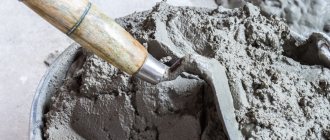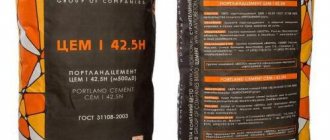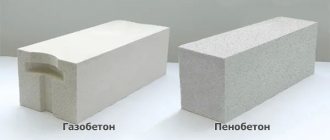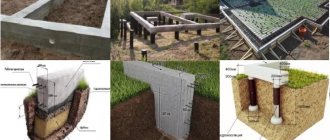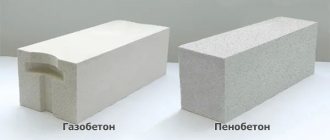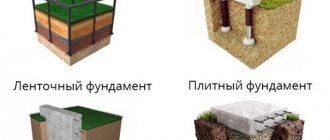When carrying out construction work, cement remains an indispensable material. Cement is a powdered building binder material consisting of:
- clinker (an intermediate product in the production of cement);
- additives;
- plaster (if necessary).
Interacting with water or with special solutions, after mixing, cement forms a plastic mass, which after time hardens and turns into solid stone.
There are many types of cement. They are distinguished by marking (name) and properties (technical characteristics). Each type of cement is marked with reference to regulatory documents, such as State Standard 10178 of 1985. Some of the most popular brands are M400 and M500.
Types of cement
Cement is essentially a synthetic binder, which, when certain fractions are added, becomes plastic and has increased strength properties. Conventionally, cement is classified by markings ranging from M-100 to M-600. In our article we will focus on the most common types of cement, which are most often used on construction sites, these include M-400, 500
In modern industry, scientific work has been carried out for a long time, trying to improve it with cement: they are finalizing the structure of the material, aimed at various fields of application. Thus, there are many modifications that can be used to solve planned problems. Before choosing and choosing a specific brand of cement, it is necessary to take into account that each brand has its own qualitative characteristics and, accordingly, is intended to solve a specific problem. For example, by purchasing cement produced under the M-200 marking, it is impossible to lay a sufficiently strong foundation, since the characteristics of this cement are more suitable for performing plastering and finishing work, and are also widely used for leveling the floor base. This brand of cement is an excellent solution for interior finishing work. Depending on the tasks to be solved, it is necessary to select a specific marking of the cement mixture.
Composition and fractions
In addition to the additives used, the quality and characteristics of cements are directly influenced by such factors as the fineness of their grinding, the granulometric composition of the product, as well as the shape of the particles included in the powder mixture.
The bulk of cement compositions, as a rule, consists of grains having sizes from 5-10 to 30-40 microns. The quality of the grinding material is determined by the presence of residues on sieves with mesh sizes of 0.2, 0.08 or 0.06 mm, as well as by testing on specialized devices that determine the specific surface area of the powder.
These devices also serve to determine the air permeability of the material.
Modern industry produces cements that are as finely ground as possible, with increased strength and a high hardening rate. For example, ordinary Portland cements are crushed to 5-8% particle residue on a 0.08 sieve. Grinding of fast-hardening cements occurs to a residue of 2-4% or less.
The specific surface area is 2500-3000 cm2/g of product in the first case and 3500-4500 cm2/g of material in the second.
Comparative characteristics of cement produced under the marking M-400,500
Despite the fact that the markings are practically at the same level, even in this there are some differences, which are primarily based on different strength coefficients. Thus, before starting the construction process, it is worth defining the tasks in more detail and deciding on the marking of cement. M-400 differs from its counterpart in that it has average strength indicators. This brand of cement is ideal for concreting the floor base, sealing joints, and for plastering work. It has increased strength and density coefficients, and also has a high level of frost resistance.
M-500 is intended for solving larger-scale and most important tasks. Using this marking, you can safely lay a foundation or erect load-bearing structures, since the level of strength allows it to be used to solve these problems. In addition, it is suitable for construction in conditions of high humidity, as it has increased moisture resistance properties.
Choosing construction material when purchasing
When purchasing cement, carefully study the packaging. Pay attention to:
- date of manufacture (in order to preserve all its properties, cement must be stored in intact, undamaged packaging for 6 months in a dry place);
- labeling (it will indicate the strength and the presence or absence of additives);
- integrity of the packaging.
It is preferable to buy cement in bags rather than in bulk, since you yourself can control the quality of the purchased product.
M500 grade cement: characteristics, features, application
The first type is M 500 D0, a mixture without impurities or additives. It is most popular in industrial construction, since when added to concrete, it gives it additional strength, frost resistance, and water resistance.
Thus, the structures are much more reliable than when using the M400 brand, which has slightly worse characteristics (withstands less load).
The second grade of cement M500 - D20 - contains 20% additives. In addition to good frost-resistant and water-resistant qualities, it perfectly resists corrosive influences.
Most often, builders use it in masonry, plastering and other repair and construction work, and add it to various mortars.
Main differences
Of course, both brands under consideration are valued in construction for their high strength and resistance to corrosion, but this does not make them identical. Let's look at the main differences between the two products:
| M400 | M500 | |
| Solidification (the rate of transformation of the solution into solid material - the quality of the clay rock plays an important role here) | 10-12 hours | 8-9 hours |
| Moisture resistance (shows the degree of exposure to water) | 22-25% | 25-28% |
| Strength (determined by crushing several ready-made concrete blocks of equal volume using the compression method) | 38 | 47,5 |
| Amount of impurities (additional components in the cement are designed to reduce the cost of the product) | 15-20% | 10-15% |
| Harmful chemical elements (formaldehyde, chromium, nickel, etc.) | 4 | 4,5 |
Read on to find out more!
How to replace a vibrator for concrete
Concrete: properties, types and applications
Two of the best concrete mix recipes
Vertical concrete placement technique
Protective layer of concrete for reinforcement
Concrete grade for strip foundation
- 2.6
Rating: 2.6 out of 5 Votes: 203
- 6
Reply
6 years ago
Alexander
6 years ago
Quote
5 years ago I built a garage. I didn’t think much when choosing - I took the middle price category. Then I settled on the one I liked best in terms of price/quality ratio. If I had read this article earlier, I would have at least paid attention to the markings of the cement.
Sergey
6 years ago
Quote
In stores there are also ShPTs and PTs markings, but this is difficult to figure out. Grade 400 and 500 are strengths, but the amount of slag indicated by the letter Ш in Portland cement is a mystery to me. What it affects, how it changes the properties of cement, not a single seller clearly answered. I plastered with both and didn’t notice any significant differences. The SPC even grabs stronger and faster, in my opinion. Although it costs a little less than PC.
Devon
6 years ago
Quote
M500, as for me, is an order of magnitude higher than its predecessor M400. The cement of this brand is very durable and can withstand both heat and cold, various temperature changes and at the same time does not crumble and retains its shape. Concrete made from the M500 grade is of the highest quality!
Svetlana
6 years ago
Quote
3 years ago, dad poured the foundation under the house, but today there is almost none left. We used M-400, but I think that it is not only the cement that is to blame for this, but also how correctly you prepare the cement mixture. Your video contains very good information, now I understand that when dad mixed the mixture by eye, he made a big mistake. As they say: the greedy pays twice.
Sergey
6 years ago
Quote
Go to comment! Sergey There are also ShPTs and PTs markings in stores, but this is difficult to figure out. Grade 400 and 500 are strengths, but the amount of slag indicated by the letter Ш in Portland cement is a mystery to me. What it affects, how it changes the properties of cement, not a single seller clearly answered.
This type of Portland cement is recommended for use in cold periods; it has increased heat transfer, which has a positive effect when setting at low temperatures, i.e., prevents the concrete from freezing ahead of time. But after reading the article on stamps, I felt a feeling of regret about the lack of such literature at hand before. When building a house, I bought 1.5 tons of cement from oil workers for pouring into wells, the grade, I think, was no lower than 600, and I thoughtlessly used this treasure in the proportion 1: 3: 5, the color of the concrete seemed strange to me, it was bluish.
Vadim
6 years ago
Quote
There is a good video on YouTube, where a guy very clearly explains about the old and new marking systems according to GOST 1985 and 2003 and their relationship. It's not so clear when you read it yourself. Now regarding the cement. Now for work I try, if it’s on sale, to buy quick-hardening cement, I think it’s clear from the name why. It is usually marked with the letter “B”, foreign ones with the letter “R”. Their choice is now quite large, I personally like the Master Universal, it’s easy to use. There are also imported ones, but these are not for everyone. Yes, and regarding the brands of cement, in stores now you are unlikely to find cement on the packaging that will indicate a grade lower than 400, at least I have not seen one for a long time. But to ensure that the bag contains exactly what is written on the bag, try to buy it in large construction supermarkets.
Comparison
To determine the difference between M-400 and M-500 cement, you should understand the labeling. The letter “M” at the beginning refers to the maximum load that ready-made cement can withstand without destruction. And the numbers indicate specific strength parameters.
The higher the number on the right side, the more the material can withstand. In our case, cement M-400 is less resistant. Reinforced concrete products are made on its basis. The product of this brand is also used in plaster mortars and compositions for filling the space between bricks during their laying. M-400 cement performs well in low-rise construction.
And where increased demands are placed on materials regarding their strength, composition M-500 is used. Cement of this category is used for the construction of reliable earthquake-resistant foundations, which become the basis of multi-story buildings. Concrete is made from it for the construction of residential and industrial facilities, as well as load-bearing structures such as bridges, airfield ground slabs, and high-rise buildings.
An important characteristic of any brand of cement is the speed of hardening. What is the difference between M-400 and M-500 cement in this regard? The fact is that the material of the first sample hardens more slowly. This can be regarded as an advantage, because the risk of defects during the formation of products in this case is minimal.
M-500 sets faster. Therefore, when working with such a material, even a slight deviation in compliance with the technology can lead to the appearance of internal pores or cracks on the surface of the product. At the same time, due to the relatively high hardening speed, M-500 grade cement becomes indispensable when carrying out emergency repairs.
Source
Scope of use
The scope of application is determined not only by the composition, but also by the grade of cement in terms of compressive strength. The higher it is, the more reliable the structures and the longer their service life. Therefore, when choosing which cement is better: D0 or D20, you need to take into account the purpose and conditions of use of the objects.
Among the most common are:
- M400 D0
It is characterized by high frost resistance, average shrinkage deformations and hardening rates. It is used for the manufacture of prefabricated and monolithic structures in private construction and the construction of industrial facilities. - M400 D20
is characterized by average shrinkage deformations, frost resistance and hardening rate. Used for the production of various concrete structures. - M500 D0
is characterized by high frost resistance and durability. Therefore, it is used in the construction of large industrial structures, bridge structures, airfield pavements and during various restoration work. - M500 D20
has average frost resistance and hardening. Serves as a raw material for casting monolithic products, in private construction and decoration.
How thick should a screed be on the street?
When used separately for the underlying sand layer, its thickness should be
at least 60 mm (preferably 100 mm); for the slag, gravel and crushed stone layer its
thickness
is at least 80 mm (preferably 80-90 mm).
Interesting materials:
What is a modular system? What is the general tax system? What is an information system operator? What is the musculoskeletal system? What is organic damage to the nervous system? What is the basic tax system? What is an Internet search engine? What is a lesion of the central nervous system? What is the information systems profession? What is EFS Encrypting File System?
Briefly about the main thing
Cement is a binding component with a mineral composition that is used to prepare various types of building mixtures and solutions.
Technical characteristics are set both by the basic composition of the clinker powder and by chemically active impurities.
Comparing cement M400 and M500, one main difference can be identified - strength indicators.
This is reflected in the percentage of components in solutions with identical technical characteristics.
Cement is produced in compliance with approved regulations, so the quality of foreign products is virtually no different from domestic ones.
The only exception is white cement, which is better to choose among imported brands for its increased whiteness.
Write in the comments what you think - is it worth replacing the more durable M500 cement with more inexpensive M400 for general construction work?

